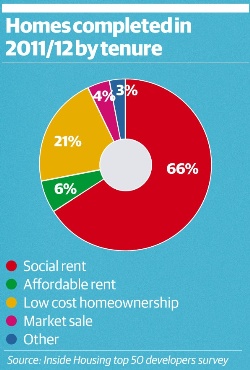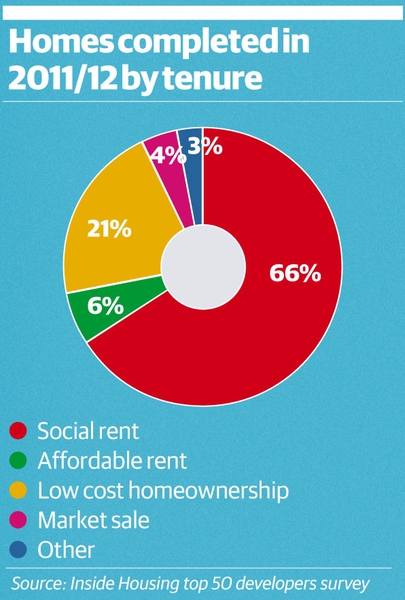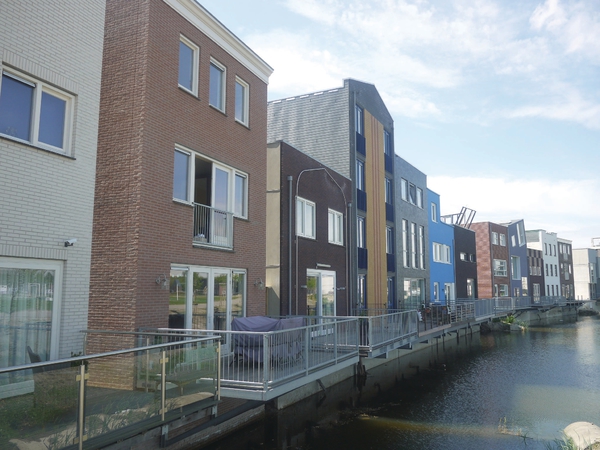Calm before the storm
The affordable homes programme launched almost 12 months ago, so how has it impacted on house building? Jess McCabe and Gene Robertson kick off our development special with an exclusive survey of the top 50 English developing housing associations to find out.
The top 50 English developing housing associations are basking in the sunshine. Despite gloomy headlines about construction, this year they exceeded their own forecast, building more homes than predicted (see box for links to for the full results).
But is the weather about to turn? This year’s completions were funded with grants from the dying days of the old national affordable housing programme. The new, affordable homes programme is bringing with it a cold front of difficulties - and in the long term, uncertainty about how the climate will change.
Inside Housing’s annual survey of the sector’s top 50 developers reveals which housing associations completed the most homes, of any tenure, between 1 April 2011 and 31 March 2012. Collectively the top 50 built 34,435 homes during the last financial year. While not a record-breaking statistic this is an 11 per cent rise on the number completed by those that made it into our top 50 for 2010/11, and a greater number than last year’s top 50 predicted.
Nine housing associations dropped out of the top 50 this year, so the numbers are a guide rather than being directly comparable. But last year’s top 50 built 31,125 homes in 2010/11, and told us they expected to complete 33,941 in 2011/12.

Richard Hill, deputy chief executive of the Homes and Communities Agency, is certainly impressed with the year’s performance, saying: ‘2011/12 was a very good delivery year.’
Despite this, Mr Hill points out that 2011/12 is a ‘transition year’.’Most of the completions this year [are] social rent [due to the fact many were funded under the NAHP],’ he adds. Two-thirds of the homes completed by the top 50 in 2011/12 will be let at social rents.
Last financial year was the first time, however, that the new affordable homes programme has had any impact on the figures. Affordable rents are a new form of tenure created by the coalition government and allow social landlords to charge rents at up to 80 per cent of the market rate - often significantly higher than social rent levels.
Although this is the first year of the affordable homes programme, it was still a minority sport for housing associations in 2011/12. The top 50 completed 2,001 affordable and intermediate rent homes - just under 6 per cent of their total.
Storms on the horizon
This is set to be the last moment in the sun for social rent, however. The HCA has allocated £4.5 billion in grant for associations to build just under 63,000 homes for affordable rents between now and 2015.
Sentinel Housing Association is one of those still benefiting from funding received under the previous regime. The 8,366-home association is one of the biggest risers in this year’s league table, leaping from 44th place to 27th and completing 570 homes.
Martin Nurse, Sentinel’s chief executive, states that this is ‘a reflection of the amount of grant that came into the system, mainly in 2010,’ a year in which Sentinel received about £45 million from the HCA.
There are some associations that give a greater insight into the new regime that is coming over the horizon, however. Town & Country Group completed 130 affordable homes last year, more than a quarter of its entire build programme. This also marks the end of new build social housing for the association. It is one of only a handful of the top 50 to entirely halt building homes for social rent - last year it started 116 affordable homes and no social homes.
Colin Lissenden, the association’s development director, explains it is ahead of the pack in moving towards affordable rent because Town & Country had taken part in the settled homes initiative pilot project funded by the HCA and London mayor, which started in 2007/08 in Bromley and financed homes with less grant, but higher rents. ‘It gave us a really clear understanding of what the affordable rent model was,’ he says. So when affordable rent began, ‘we were relatively comfortable with it. We were one of the first to sign up.’
In terms of this year’s table, there are a few associations that continue to swap places in the top 10, but much more volatility in the rest of the rankings. There were nine new entrants this year, with the highest, Accent Group, coming in at 17th with 803 completions. But the association will build barely half this number - 468 - in the next year and started just 73 homes last year as the amount of grant it received has gone down.
Catalyst saw the most meteoric rise from 40th place to third this year. This was fully predicted last year - when the 21,000-home association said it planned to build 1,719 homes.
If it had matched this estimate it would have ousted L&Q from the top spot, but, completing 1,466 homes was still an impressive jump. ‘There’s some that we haven’t quite formally handed over [to residents] yet, that we might have expected to,’ a spokesperson explains.
As it is, the association adopted a target five years ago to double its annual construction from 500 a year, to 1,000 a year from 2012, which it has comfortably exceeded.
Of the nine that dropped out of the rankings, two - Longhurst, which was 38th and Spectrum, which came 50th last year - refused to supply or did not respond to requests for their data. Of those that did respond, Asra Housing Group, which last year placed 19th after completing 654 homes, finished just 203 homes in 2011/12. And Hanover, which placed 46th last year with 274 homes, neither completed nor started any homes last year.
Claire Anderson, development and services director at Hanover, says this was because of ‘a planned transition to build retirement homes’, adding that Hanover plans to build about 250 homes a year for the next five years.
Development forecast
If most of this makes for somewhat cheery reading, the forecast for next year is for a cold front to sweep over developers. Our second league table ranks of the top 50 housing associations by the number of homes they expect to complete in 2012/13. The total number predicted is 29,931 - down by about 10 per cent on this year’s delivery.
Even this might be something of a stretch. They have started construction on 15,938 homes in the last year: half the number started in 2010/11, while this year’s top 50 by completions started 17,350.
This certainly seems to fall in line with official predictions: government statistics show the number of starts on new housing developments by housing associations dropped 21 per cent to 19,320 in the first three months of 2012, compared with 24,580 in the same period in 2011.
Our table topping champ L&Q, which built 1,608 homes last year putting the London and south east-based association at the top of the league table for completions, certainly signs up to this slightly more gloomy prognosis.
The organisation completed more than 400 more homes than the 1,200 it was predicting last year. But Jerome Geoghegan, group director of development and sales at L&Q, says: ‘I’m not surprised that overall numbers [of predicted completions] are down, because affordable rent requires the social landlord to take considerably more risk. You eat capacity [the financial capacity it takes to build] much quicker than under the old model.’
Developing associations explained this is because the level of grant has decreased and organisations must use their own balance sheet or borrow to pay for new homes.
‘It’s happening in what’s still a difficult marketplace - I’d expect [home building] to continue at a lower level,’ Mr Geoghegan adds. L&Q expects to build 1,143 homes next year.
Of course, landlords which are continuing to build in 2012/13 need one thing above all else - available land on which to place the homes.
Land grab
This year we asked a new set of questions to find out how successful our developing landlords have been in lining up sites. The results were mixed, to say the least. A full 16 per cent of the sites needed in 2012/13 have not been secured - equating to almost 6,000 homes.
Looking forward to 2015 and the remainder of the affordable homes programme, and the split is even more dramatic - sites have been secured for only half the homes the top 50 plan to build.
The top three developers by completions, L&Q, Notting Hill Housing Group and Catalyst, have the most certain pipeline having secured sites for almost 100 per cent of the homes they expect to build in the next year, and the vast majority up to 2015.
Others seem to be in a less secure position. Great Places, for example, expects to build 781 homes in 2012/13, but has sites secured for just 306. ‘The development process is quite complex with landowners always playing brinksmanship and last-minute complications and delays to planning applications,’ explains James McMillan, its assistant director of development. ‘Quite often schemes will fall through at the last minute but we always have other irons in the fire to take up the slack.’
Sara Bailey, a partner in the housing projects department at law firm Trowers & Hamlins, seems unfazed by the fact that housing associations haven’t secured sites for many of the homes they plan to build: ‘I wouldn’t panic yet if I were them.’
She says this is partly because last year was unusual as the switchover to the affordable homes programme led to a development hiatus as new contracts were signed and delayed work.
To look at the broader reason for the drop in new starts and homes to be completed next year, we can return to Sentinel. Last year, it received £10.1 million in grant, already a major drop from the £45 million it received in 2010. Now it has just a £5 million grant under the 2011/15 programme.
Sentinel expects to complete 250 homes next year, and 1,200 by April 2015 when the current affordable homes programme comes to an end. This means it will be squeezing many more homes out of each £1 million of grant than it has in the past.
Mr Nurse notes that three years ago, the association hired experts from the private sector to bolster the experience on its development team, and this is starting to pay off with more homes being built. ‘But at the moment we are looking at producing homes without grant.’
Section 106
There is, of course, another important area to consider - section 106 agreements. Under these agreements with local authorities, private developers can be required to include a certain percentage of affordable homes in their developments. In future, the government does not want associations to use grant funding to buy section 106 homes, as they would be built anyway without subsidies.
We asked the top 50 how many of the new homes they are adding to 2015 will be through section 106 agreements - and of this, how many will be grant funded. The answers varied wildly; from 10,350-home Swan Housing, which obtains no homes from section 106 agreements, to 16,059-home Jephson Homes, whose pipeline of 1,189 homes by April 2015 is 90 per cent from section 106 (although just 10 per cent is grant-funded).
There is evidence of a changing picture here too. Genesis, for example - second place by future development, as it expects to build 1,509 homes in 2012/13 - says half its committed developments programme is section 106 - of this, all is grant funded. But none of its pipeline will be section 106.
Tracy Williams, deputy director of development at Genesis, explains: ‘We are focusing on purchasing our own land and developing out our current pipeline of land acquisitions, or entering risk-sharing arrangements with a developer rather than being the recipient of section 106 units. This gives us a better ability to be able to control our programme delivery and management arrangements.’
Looking ahead, the top 50 are most worried about one big looming dark cloud - the end of the affordable homes programme in April 2015.
It sounds a long way off, but it’s not. As Mr Nurse, Sentinel’s chief executive, says: ‘We are looking at a 10-year supply of land.’
Mr Geoghegan at L&Q says that the lack of policy after 2015 is already starting to affect the association’s plans - if it wants to buy land today, he explains, it’s likely the homes wouldn’t be completed by April 2015. L&Q is still buying land, but is taking a ‘prudent’ approach. ‘What comes after March 2015 is as important to us as the current regime,’ he says.
‘We’re in an unusual situation. Certainly in my career, I don’t recall a situation where we’ve got a model that comes to an end without an obvious successor being in place.’
The top 50 results
See the full results of our exclusive survey
How the top 50 was compiled
Inside Housing asked the 100 biggest English housing associations in terms of the number of homes they own and manage, plus a number that were part of last year’s survey, a series of questions about how many homes they built in the last year and their development pipeline to 2015, when the current affordable homes programme ends.
We have included two top 50 rankings: the first is based on the actual homes that associations have completed in the last financial year. The second, more speculative ranking, is based on the number of homes that associations hope to build in the next year and by 2015. The aim is to give an accurate picture of which organisations are building the most now, and how the picture will change in the coming years.
The rankings were compiled based on their answers and rely on the associations to be honest. As in previous years, we will spot-check their end-of-year reports to check the accuracy of the numbers we have printed here.













